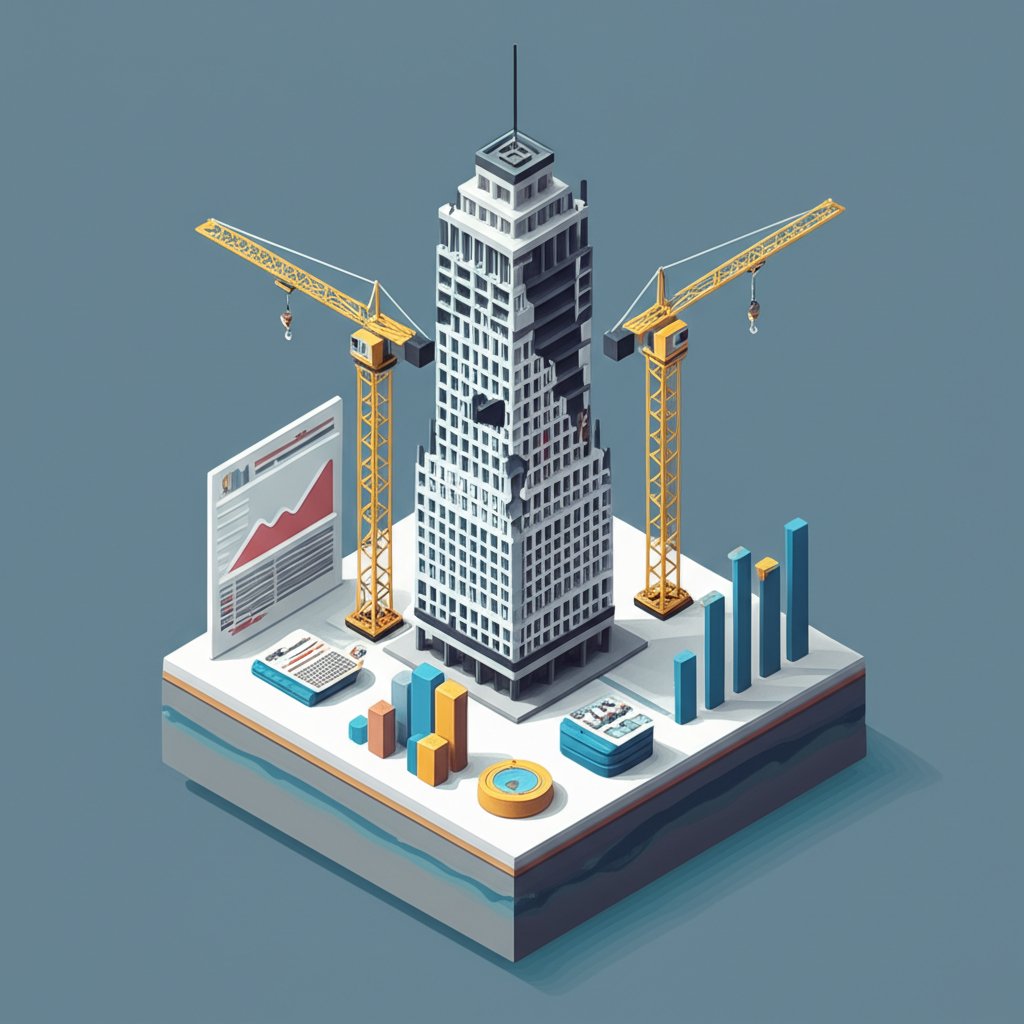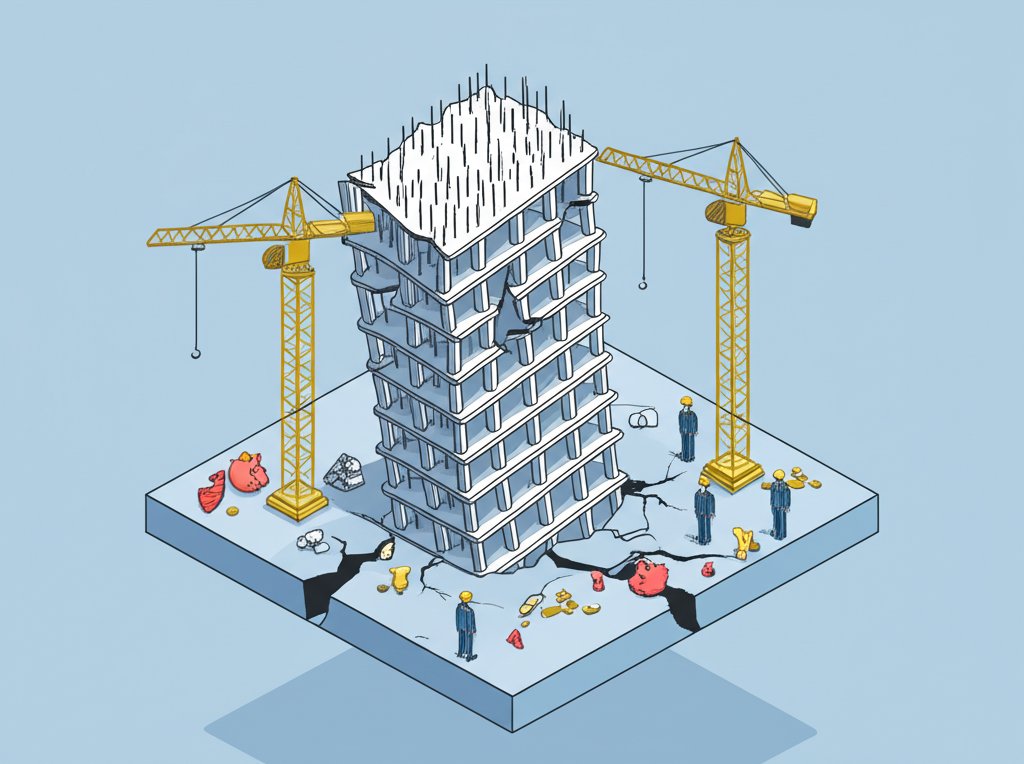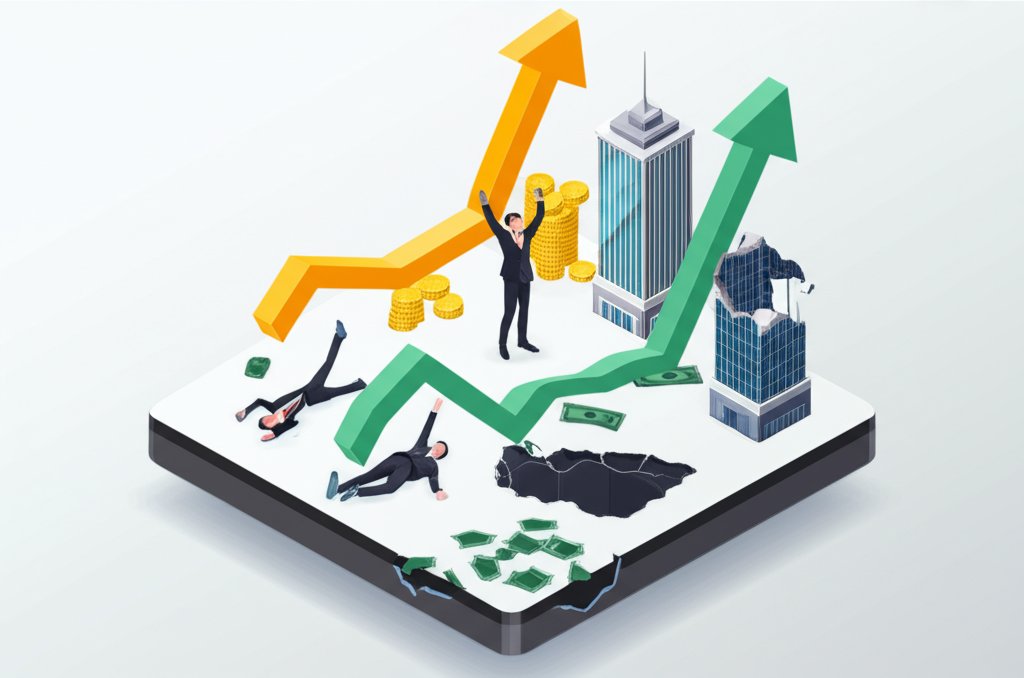Prepare yourself for an extraordinary journey into the life of Hui Ka Yan, the ambitious entrepreneur who built the colossal China Evergrande Group. From the humble poverty of rural China to becoming one of the nation’s wealthiest Real Estate Tycoons, his story is a breathtaking saga of ambition, unprecedented growth, and an eventual, spectacular downfall. This article will delve into the unbelievable facts of Hui Ka Yan’s trajectory, shining a light on his strategic genius, the intricate world of Real Estate China, and the systemic forces that ultimately led to his empire’s collapse. Get ready to uncover the captivating and complex narrative of a man who personified the boom and bust of modern China’s property market.
The Humble Beginnings of a Real Estate Tycoon
Before he commanded one of the largest property empires, Hui Ka Yan’s life began far from the glittering skyscrapers of his future. His origins are a testament to the transformative power of China’s economic reforms, illustrating a classic rags-to-riches tale that many once believed was only possible in fiction.
Early Life and Education in Rural China
Born in 1958 in a rural village in Taikang County, Henan province, Hui Ka Yan experienced a childhood marked by struggle. His mother died when he was young, and he was raised by his grandmother. Access to education was a luxury, but Hui persevered, attending a local primary school before enrolling in the Wuhan Institute of Iron and Steel (now Wuhan University of Science and Technology) in 1978. This was a pivotal moment, as it coincided with the resumption of the Gaokao (national college entrance examination) after the Cultural Revolution, offering a rare ladder to social mobility. His engineering education provided him with a foundational understanding of large-scale projects, a skill that would prove invaluable.
First Forays into Business and Early Career
Upon graduation in 1982, Hui was assigned to work at a state-owned steel company in Wuyang, Henan. He spent a decade there, rising through the ranks and gaining crucial experience in management, production, and dealing with large-scale industrial operations. This period, while seemingly far removed from property development, instilled in him a deep understanding of logistics, supply chains, and the practicalities of construction that would later define China Evergrande. It also exposed him to the bureaucratic intricacies of state-owned enterprises, teaching him the importance of relationships and strategic navigation within China’s unique economic landscape. These Hui Ka Yan facts paint a picture of a man who learned the ropes from the ground up.
The Meteoric Ascent of China Evergrande
The 1990s marked a new era for China, with rapid urbanization and the nascent private property market creating unprecedented opportunities. Hui Ka Yan was perfectly positioned to seize this moment, founding China Evergrande Group in 1996 in Guangzhou.
Founding Vision and Early Growth in Real Estate China
Hui’s vision was audacious: to build mass-market, high-quality, and affordable homes for China’s burgeoning middle class. Unlike many competitors who focused solely on high-end luxury, Evergrande targeted second and third-tier cities, which were experiencing explosive growth. This strategy allowed them to acquire land at lower prices and serve a massive, underserved market. The company’s rapid growth was fueled by an innovative, albeit risky, business model. Evergrande would acquire vast tracts of land, often through debt, and then quickly sell units off-plan, using the proceeds to fund construction and acquire more land. This “high-leverage, high-turnover” model became the hallmark of Real Estate China’s expansion in the early 2000s.
Debt-Fueled Expansion and Strategic Acquisitions
Evergrande’s expansion was nothing short of breathtaking. From its base in Guangzhou, it quickly spread across the country, embarking on over 1,300 projects in 280 cities at its peak. This growth was largely debt-fueled. Hui Ka Yan was a master at leveraging financing from banks, shadow banking institutions, and by issuing high-yield bonds to international investors. His ability to cultivate strong relationships with local governments also proved critical, allowing Evergrande to secure prime land parcels and navigate regulatory hurdles with relative ease. This aggressive approach transformed China Evergrande into the nation’s second-largest property developer by sales.
Diversification Beyond Property: A Real Estate Tycoon’s Broader Ambitions
Hui Ka Yan’s ambitions extended far beyond concrete and steel. He envisioned Evergrande as a diversified conglomerate, venturing into a myriad of sectors:
- Electric Vehicles (EVs): In one of his boldest moves, Hui poured billions into Evergrande New Energy Vehicle Group, aiming to become the world’s largest EV maker within three to five years. This investment was seen by some as visionary, by others as a speculative gamble, especially given the company’s lack of automotive experience.
- Sports and Entertainment: Evergrande acquired the Guangzhou Football Club (now Guangzhou FC) in 2010, transforming it into a powerhouse that won multiple Chinese Super League titles and two AFC Champions League titles. This brought national recognition and brand prestige to China Evergrande.
- Health and Wellness: The company also invested in Evergrande Health Land, focusing on elder care, healthcare facilities, and even bottled water.
- Finance: Evergrande established its own wealth management products, attracting retail investors with high returns, further deepening its intertwining with the broader financial system.
These incredible Hui Ka Yan facts showcase a Real Estate Tycoon who dreamed of an empire touching every facet of modern Chinese life, driven by an unshakeable belief in rapid growth and diversification.
While Hui Ka Yan’s story is unique, understanding broader market forces and the fundamentals of property investment, including key real estate facts, helps contextualize both his rise and fall.
Unbelievable Hui Ka Yan Facts: Beyond the Headlines

Hui Ka Yan’s journey is punctuated by fascinating details and contradictions that paint a more complete picture of the man behind the empire.
Astounding Philanthropic Endeavors
Despite his reputation for aggressive business tactics, Hui Ka Yan was also known for his immense philanthropy. He regularly featured on China’s top donor lists, with China Evergrande contributing billions of dollars to poverty alleviation, education, healthcare, and disaster relief. For instance, Evergrande reportedly invested billions in rejuvenating Duyang County, Guizhou, a poverty-stricken region. While some saw this as genuine altruism, others viewed it through a more cynical lens, recognizing that such large-scale charitable acts often build crucial political capital and demonstrate alignment with government priorities in China.
Strategic Political Connections and Influence
One of the most defining and, for some, unbelievable facts of Hui Ka Yan’s success was his mastery of political navigation. He cultivated deep relationships with high-ranking officials and was a prominent member of China’s top political advisory body, the Chinese People’s Political Consultative Conference (CPPCC). Such connections provided Evergrande with a significant advantage, from securing favorable land deals to smoother project approvals. In Real Estate China, the intertwining of business and government is a critical factor, and Hui was a prime example of someone who excelled in this complex environment. His political savvy was as important as his business acumen.
The Enigmatic Private Life of a Billionaire
Despite his immense wealth—at his peak, he was briefly Asia’s richest man with a net worth exceeding $40 billion—Hui Ka Yan maintained a surprisingly private life. He rarely gave interviews or courted the spotlight, preferring to let Evergrande’s towering projects and aggressive marketing speak for themselves. This enigmatic persona added to his mystique, contrasting with the often-flashy displays of wealth seen with other global billionaires. This privacy was perhaps a calculated move in a country where high-profile figures can quickly attract unwanted governmental scrutiny.
A Risk-Taker at Heart: The “Leverage King”
Hui Ka Yan was undeniably a risk-taker. His entire business model was built on leverage, often borrowing heavily to fund new ventures. He earned nicknames like “Debt King” and “Leverage King” for his aggressive borrowing strategies. His foray into electric vehicles, despite Evergrande’s already mounting debt, exemplified this willingness to gamble on future trends, even if the odds seemed stacked against him. This characteristic, which propelled him to such heights, ultimately also played a significant role in his downfall, demonstrating the razor-thin line between visionary and reckless in the world of high finance. These Hui Ka Yan facts highlight the double-edged sword of his ambitious nature.
The Looming Crisis: How the Empire Began to Crumble
The dizzying ascent of China Evergrande was not sustainable indefinitely. The seeds of its eventual collapse were sown in its very growth model, compounded by shifts in government policy.
Regulatory Crackdown: The “Three Red Lines” Policy
The turning point came in August 2020 when the Chinese government introduced the “Three Red Lines” policy, a set of strict regulations designed to curb developer debt and reduce systemic risk in Real Estate China. These rules targeted:
- A liability-to-asset ratio (excluding pre-sales) of less than 70%.
- A net debt-to-equity ratio of less than 100%.
- A cash-to-short-term debt ratio of more than 1x.
China Evergrande failed all three metrics, effectively drastically limiting its ability to borrow new funds. This policy effectively choked off the oxygen supply to Evergrande’s debt-fueled growth engine, forcing a dramatic deleveraging that the company was ill-equipped to handle.
Escalating Debt and Missed Payments
With borrowing curtailed, Evergrande’s vast network of ongoing projects, suppliers, and contractors began to feel the pinch. The company’s staggering liabilities, estimated at over $300 billion, became impossible to service. By late 2021, Evergrande began missing payments on its offshore bonds, triggering default and sending shockwaves through global financial markets. Protests erupted across China as homebuyers demanded delivery of their unfinished apartments, and suppliers called for payment. These events laid bare the severe liquidity crisis gripping the once-invincible Real Estate Tycoon’s empire.
Impact on the Chinese Real Estate Market
The crisis at China Evergrande was not an isolated incident; it quickly reverberated throughout Real Estate China. Other developers faced similar deleveraging pressures, leading to a broader slowdown in the property market. Consumer confidence plummeted, impacting sales and exacerbating the financial woes of many firms. The crisis highlighted the systemic risks of China’s property sector, which accounts for a significant portion of the country’s GDP and household wealth. The government was left with the challenge of managing a “controlled demolition” of overleveraged developers without triggering a wider economic collapse.
The Fall from Grace: Investigations and Liquidation

The dramatic fall culminated in the detention of Hui Ka Yan and the ultimate liquidation of China Evergrande, marking the end of an era for one of Real Estate China’s most iconic figures.
Detention and Allegations Against Hui Ka Yan
In September 2023, news broke that Hui Ka Yan had been placed under “residential surveillance” by Chinese authorities on suspicion of “illegal crimes,” though specific charges remain officially undisclosed. This marked a stunning reversal of fortune for the once-powerful Real Estate Tycoon. While the exact nature of the allegations is opaque, it is widely believed that the investigation relates to Evergrande’s financial mismanagement and potential misuse of funds. His detention sent a clear signal that even the most connected billionaires are not immune from the Communist Party’s crackdown on perceived financial malfeasance.
Evergrande’s Delisting and Restructuring Efforts
After defaulting on its debts, China Evergrande entered a complex and drawn-out restructuring process. However, these efforts proved insufficient. In January 2024, a Hong Kong court ordered the liquidation of Evergrande, deeming its restructuring plan unfeasible. This decision marked the official end of the company as a publicly listed entity and initiated a process to seize and sell off its assets to repay creditors. The company was subsequently delisted from the Hong Kong Stock Exchange. The liquidators are now tasked with the monumental challenge of unwinding an empire with vast assets and even vaster liabilities, a process expected to take years. These are the most recent and sobering Hui Ka Yan facts, cementing his fall.
Broader Economic Implications of China Evergrande’s Collapse
The collapse of China Evergrande and the detention of its founder have far-reaching implications, not just for Real Estate China but for the global economy. It exposed fundamental weaknesses in China’s growth model, particularly its reliance on debt-fueled property development. The crisis has led to:
- Financial Contagion Fears: Worries that Evergrande’s collapse could trigger a domino effect across China’s financial system and even spill over into global markets.
- Economic Slowdown: The property sector slowdown has had a significant drag on China’s overall economic growth.
- Social Unrest: The unfinished properties have led to widespread discontent among homebuyers, posing a social stability challenge for the government.
- Investor Caution: International investors have become significantly warier of investing in Chinese companies, particularly those in the property sector.
Hui Ka Yan’s story serves as a cautionary tale of unchecked ambition, the perils of excessive leverage, and the power of state intervention in a centrally planned economy.
Conclusion: The Unfinished Legacy of a Real Estate Tycoon
The story of Hui Ka Yan is a compelling narrative that encapsulates the dramatic economic transformation of modern China. From his humble beginnings, he rose to become an undisputed Real Estate Tycoon, building China Evergrande into an empire that reshaped skylines across Real Estate China. His strategic vision, relentless ambition, and mastery of political networking propelled him to unimaginable heights, creating billions in wealth.
However, the very strategies that fueled his meteoric rise—aggressive debt accumulation, rapid expansion, and bold diversification—ultimately became the instruments of his spectacular downfall. The government’s decisive intervention with the “Three Red Lines” policy proved to be the Achilles’ heel for an empire built on leverage. The unbelievable facts of Hui Ka Yan’s journey highlight the delicate balance between ambition and sustainability, innovation and risk. His current predicament, under investigation and with his company in liquidation, stands as a stark reminder that in the volatile landscape of Real Estate China, even the most powerful figures are ultimately subject to the forces of market cycles and state control. His legacy remains a complex, indelible chapter in China’s economic history.
FAQ Section
What did Hui Ka Yan do?
Hui Ka Yan founded and served as the chairman of China Evergrande Group, which grew to become one of the largest property developers in Real Estate China. He oversaw its aggressive expansion into real estate, electric vehicles, sports, and other sectors, leveraging massive amounts of debt to fuel rapid growth. He was also known for his significant philanthropic contributions and close political connections.
Where is Hui Ka Yan now?
As of late 2023, Hui Ka Yan was placed under “residential surveillance” by Chinese authorities on suspicion of “illegal crimes.” The exact charges and his precise location have not been publicly disclosed, but he is currently under investigation following the collapse of his China Evergrande empire.
What is China Evergrande Group?
China Evergrande Group was a massive Chinese conglomerate primarily focused on property development, founded by Hui Ka Yan in 1996. At its peak, it was one of the largest real estate companies in the world, with projects in hundreds of cities across Real Estate China. It also diversified into electric vehicles, healthcare, sports, and finance before its financial crisis. The company was ordered to liquidate in January 2024.
How did China Evergrande get into debt?
China Evergrande accumulated massive debt primarily through an aggressive “high-leverage, high-turnover” business model. They borrowed heavily to acquire land, started selling properties off-plan quickly, and used those proceeds to fund construction and acquire more land. This cycle was sustained by constant access to credit from banks, bond markets, and shadow banking. Regulatory changes by the Chinese government, particularly the “Three Red Lines” policy, curtailed their ability to borrow, leading to a liquidity crisis and default.
What impact does Evergrande’s crisis have on global markets?
The China Evergrande crisis caused significant concerns about potential contagion in global financial markets. While a full-blown global financial crisis has been avoided, its impact has included:
Who is the former richest Real Estate Tycoon in China?
Hui Ka Yan was indeed the former richest Real Estate Tycoon in China, briefly holding the title of Asia’s richest man in 2017, with a peak net worth exceeding $40 billion. His wealth was largely derived from his stake in China Evergrande Group.
Are there other famous Chinese real estate tycoons?
Yes, Real Estate China has produced several prominent tycoons alongside Hui Ka Yan, including:
These individuals, like Hui Ka Yan, represent the massive growth and subsequent challenges within Real Estate China.











1 thought on “Hui Ka Yan: Unbelievable Facts of Tycoon’s Rise & Fall”
Comments are closed.